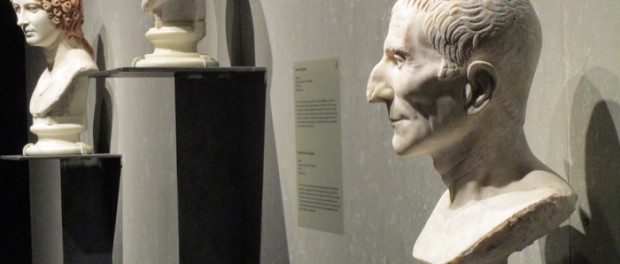Pompeii Exhibit at the MFA: The Importance of an Ordinary Day
For those who lived in and around Pompeii in the year 79 AD, the day Vesuvius erupted was one of horror and fear. Whether sheltering in their homes or fleeing to the countryside to escape, there was little chance of success. No one had even seen a volcano like this. In fact, the Romans had no word for volcano in their vocabulary. Their tragedy, though, has become a treasure for us, a window into a world that is a precursor to our own. The Pompeii exhibit at the Montreal Museum of Fine Arts lets us see that like us they enjoyed the most mundane things of life: food and drink, culture, and even shopping for favorite “brands” (I won’t mention this might be a brand of fish sauce).

Pompeii. Plaster casts of Vesuivus victims. Museum of Fine Arts. Photo Rachel Levine
There are no major gobsmacking pieces in this exhibit that occupy an entire room, but plenty of excellent minor ones that share the space. The most striking are probably the casts of the victims, gathered together in a final room with a video behind them. Dramatically lit, we see the people of Pompeii — men, women, girls, and babies — in their final moment before the pyroclastic surge sealed them in their tombs. The folds of their clothing, their tormented gestures, and even some expressions are visible in the plaster. However, these are not the originals, but 3D recreations of the newly restored casts.
The exhibit does not focus on emperors or great battles. Instead we see lives lived, and often lived rather well. Each room is roughly grouped to match with parts of a Pompeiian house. We stop in the dining room (the triclinium), the bedroom (the cubiculum), and the garden (the hortus). In each place, pottery, personal objects, and artworks are displayed to give a sense of what would have been found there. Other sections focus more on the worship of Isis, statue busts of well-to-do Romans, and a little bit of the waterworks that provided the city with its drinking water.
I was delighted by everything at the exhibit, even though Pompeii’s greatest hits weren’t here. I suppose you can’t just haul the Alexander Mosaic or the wall paintings of the Villa of the Mysteries out of Italy. The things on display might need a little bit more background information in order to appreciate just how incredible they are. Taking time to read the written texts or going on a tour might add to one’s appreciation of what is on exhibit.

Statue of Girl putting on Peplos. Pompeii. Museum of Fine Arts. Photo Rachel Levine
Highlights for me include a very beautiful bronze of a woman dressing in her peplos. One side is pinned, the other opened. She stands life sized, her smooth skin and ski slope straight nose a perfect example of how much the Italians liked classical Greek art. Everything from her ringlets to her dainty toes that peek out from under her peplos are idealistic textbook studies.

Wine heater. Pompeii. Museum of Fine Arts. Photo Rachel Levine
Much of the exhibit includes daily items and the Pompeiians clearly were not into their version of Walmart when it came to homegoods. A bronze wine heater rivals the most pricey third-wave-coffee shop’s La Marzocco. Set on lion feet, the wine heater has a spout like a satyr’s face and a woman’s bust for its handle. Tiny bronze birds perch around a spot for the wine amphora. A one handled strainer has its holes arranged in an organic, swirling floral pattern.

Pompeii. Museum of Fine Arts. Photo Rachel Levine
Gods and goddesses make their appearance, and not in the grand way one might expect. Instead we see how the gods may have decorated homes and private altars. Small statuettes of Hercules, Apollo, and Diana are on display together like tiny toy soldiers. A marble Venus rings out her long locks, her body and face falling short the high quality of her Louvre counterparts. Still, we can see some lover of the goddess of love proud to show off to his friends this statue decorating his garden. Isis in particular has a corner of the exhibit dedicated to her, where it is possible to see the instrument played in her honour, the sistrum, as well as several wall paintings that depict her worship.

Amphora for Fish sauce. Pompeii. Museum of Fine Arts. Photo Rachel Levine
For those interested in commerce, amphora, weights and measures, and even carbonized bread appear. The giant amphora for garum, fish sauce, come from a particular maker in Pompeii whose product was sort after enough to be labelled on the outside of the jar. There is even a seal ring from Qunitus Mestrius Maximius that would have been used to stamp his name onto items as a kind of branded logo.

Buying bread. Pompeii. Museum of Fine Arts. Photo Rachel Levine
Other curious additions to the exhibit include a carbonized loaf of bread and a gladiator suit. There is a room with a few phallic images, letting us know that the Pompeiians were none too squeamish about genitals.

Flying Penis. Pompeii Exhibit. Photo Rachel Levine
While the exhibit may lack the punch of the Rodin one that came through a few months ago, it is a must see for those interested in the ancient world. Pompeii is one of the most important archaeological finds ever but it is made more comprehensible by taking the time to remember that it was a city of people. Thought we mostly get to see the life of the privileged, their closeness to us is a little terrifying and gratifying at the same time.
Pompeii a Roman City runs until September 5 at the Museum of Fine Arts. Information HERE. $20/12, free for members.






